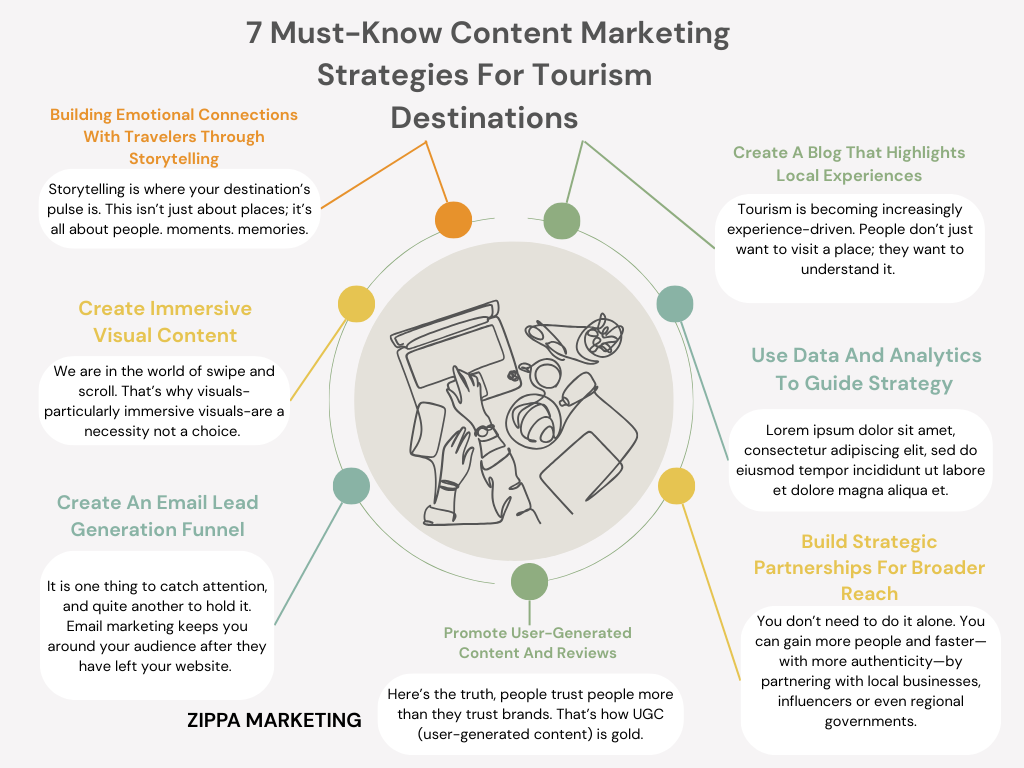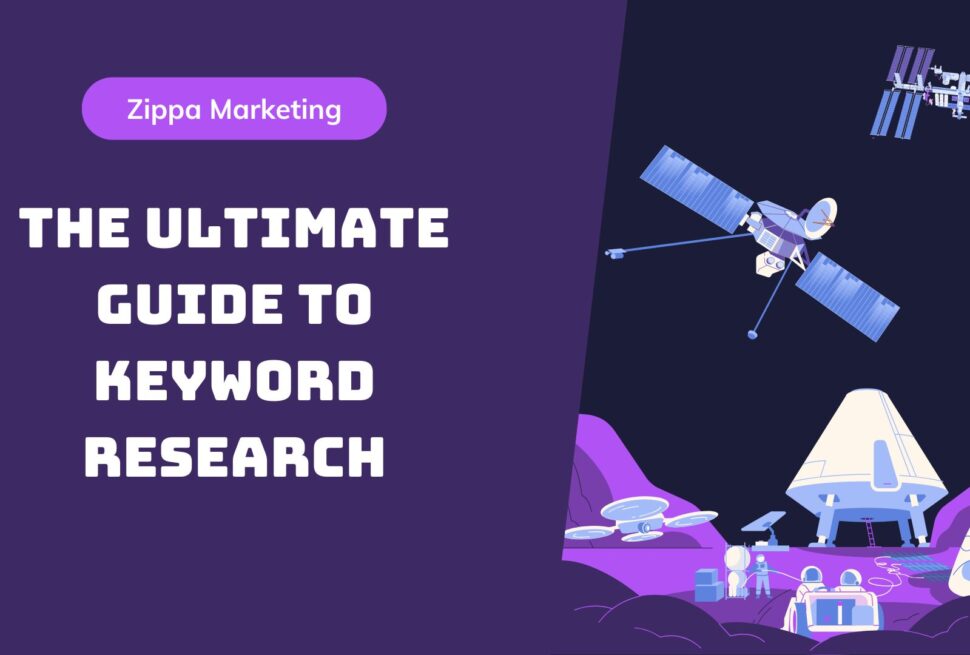Tourism is a big part of local economies; it brings in money, supports small businesses, and creates jobs. With so many places to visit, how can one location get noticed? That’s where the smart content marketing strategy comes to the fore.
Today’s travelers want more than pretty pictures. They are looking for stories, tips, and real reasons for visiting. A robust content marketing strategy allows you to get to people, win their trust, and turn the interest into actual visits.
In this article, 7 simple but powerful content marketing strategies every tourism destination should be using to reach and gain an audience will be shared with you.
Why Every Tourism Destination Needs A Solid Content Marketing Strategies
At times starting is the hardest. When you’ve got the mountain that is your content marketing strategy staring you in the face, it could be too much to handle, but once you start to split it into pieces, things become clearer. Whether you are a thriving city or a secret find, having a focused plan leads to more visibility to attract the right travelers and to turn casual interest into real bookings.
An aggressive content marketing strategy does not only spotlight what makes your destination different—it emotionally resonates with your audience and provides the reasons why people should choose you over anywhere else.
Strategy 1
Building Emotional Connections With Travelers Through Storytelling
Storytelling is where your destination’s pulse is. This isn’t just about places; it’s all about people, moments, and memories. The world-tired man or woman simply must feel something before his or her bags are ever packed, and stories do that.
– Share real, emotional stories about real visitors and local heroes.
– Demonstrate how your destination makes people change and not just entertains them.
– Embrace local culture, community rituals, and historical richness.
In the case of the smaller or emerging destinations, storytelling can even the field by providing a deeper, more meaningful tale.
And when integrated into your content marketing strategy, great stories become magnets—drawing those travelers that feel the most with your vibe.
Destination branding is not about the logo or the graphical representation of the destination… It is the sum of multiple elements all converging into a common idea or a concept which we call a brand – Nick Hall, CEO of the Digital Tourism Think Tank
Strategy 2
Creating Immersive Visual Content
We are in the world of swipe and scroll. That’s why visuals-particularly immersive visuals-are a necessity, not a choice. Human beings want to see the experience before they do it.
According to WebFX, there are 94% more views of visual content as compared to text-only content.
Visuals are used to make them visualize themselves there already.
– Telling dynamic stories through Instagram Reels, YouTube travel vlogs and TikTok.
– Display 360° photography of trails, viewpoints, or hidden locations.
– Create visual libraries through tools of content marketing strategy such as Canva, Lumen5 or InShot for editing on the go.
– Use visuals to take the users from curiosity to clicking on “Book Now.”
Immersive content brings your destination to life—and visual-first travelers will appreciate that.
Strategy 3
Create An Email Lead Generation Funnel
It is one thing to catch attention and quite another to hold it. Email marketing keeps you around your audience after they have left your website.
ResmarkWeb reported that email marketing revenue is expected to gain nearly $12.5 billion by the end of 2024.
If you adopt the correct content marketing strategy for lead generation, you convert browsers into bookers.
– Provide downloadable guides, city itineraries or secret local spots in exchange for emails.
– Create landing pages that are small stories and emotional.
– Use automated email sequences with story integration (not just dry promotion).
– Use content marketing strategy tools such as Mailchimp, ConvertKit or ActiveCampaign for funnel setup and tracking funnels.
Segmented campaigns by email have 14.31% better open rates than non-segmented ones.
When your funnel is live, it becomes a live storyteller that moves your leads towards your destination without extra effort.
Strategy 4
Promote User-Generated Content And Reviews
Here’s the truth: People trust people more than they trust brands. That’s how UGC (user-generated content) is gold. It reveals real people’s enjoyment for real and creates trust of the kind money can not purchase.
According to Crowd Riff, 55% of consumers across all age groups trust user-generated content (UGC) over other marketing strategies.
– Run campaigns asking visitors to tag you in their photos and stories.
– Feature authentic posts, videos, and reviews across your platforms.
– Create a branded hashtag that encourages participation.
– Monitor and curate UGC using content marketing strategy tools like Later or TINT.
Your audience is already talking about you; this strategy makes sure you’re listening and sharing it forward.
Strategy 5
Create A Blog That Highlights Local Experiences
Tourism is becoming increasingly experience-driven. People don’t just want to visit a place; they want to understand it.
According to Peak Pro, 74% of travelers were, in 2023, reported to have been using online platforms to plan trips.
Through blogging, you can be the trusted insider voice to curious travelers.
– Blog about hyper-local experiences: sunset spots, artisan cafes, guided hikes or indigenous markets.
– Apply SEO tools and discover long-tail keywords that your audience uses to search.
– Exploit blog categories by season, type of travel (romantic, solo, family), and duration of stay.
– Bring your posts into your social and email funnel to close the content marketing strategy for lead generation loop.
Exceptional blogs breathe life into your SEO while bragging about your destination as a unique character.
Strategy 6
Use Data And Analytics To Guide Strategy
Flying blind is not even a strategy. Data tells you what works and what doesn’t work and where your target audience reacts the most. That’s why smart marketing people listen to those numbers and develop.
Instead, install Google Analytics to monitor sources of traffic/behavior.
– Use Hotjar to see the clicks, scrolls, and exits made by the users.
– Measure what converts and where from social insights.
– Use content marketing strategy tools like SEMrush or Metricool to measure performance.
It may sound like data is boring, but it’s your best friend once you use it to tailor your content marketing strategy. It removes the guesswork about what to make next.
Strategy 7
Build Strategic Partnerships For Broader Reach
You don’t need to do it alone. You can gain more people and faster—with more authenticity—by partnering with local businesses, influencers or even regional governments.
– Develop bundled offers with hotels, tour guides or means of transport.
– Collaborate with travel influencers to co-create.
– Using co-branded campaigns to connect with each other’s crowds.
– Work together using shared content marketing strategy tools such as Trello or Google Workspace for simple project management.
– Your partnerships are like your megaphone helping your content spread much further than your current range.
Start Building Your Tourism Content Marketing Strategies Today
Developing a tailored, effective content marketing strategy isn’t about doing everything at once; it’s about doing the right things at the right time. From storytelling and immersive visuals to data-backed decision-making and strategic partnerships, each of these seven strategies works together to boost your visibility and inspire action.
Start with the strategy that feels most manageable today. Use the right content marketing strategy tools, build strong email funnels, and always circle back to emotional connection and trust.
Frequently Asked Questions
1. What Is A Content Marketing Strategy?
A content marketing strategy is a plan to attract and engage travelers using blogs, videos, and social media content.
2. How Does Content Marketing Strategies For SEO Help Tourism?
A content marketing strategy for SEO improves search engine rankings, helping more people find your destination online.
3. Can Content Marketing Strategies For Small Businesses Work In Tourism
Yes, a content marketing strategy for small businesses can highlight local attractions and connect with niche audiences effectively.
4. What Tools Help With Content Marketing Strategy For Lead Generation?
Use content marketing strategy tools like HubSpot or Google Analytics to track results and boost lead generation.




